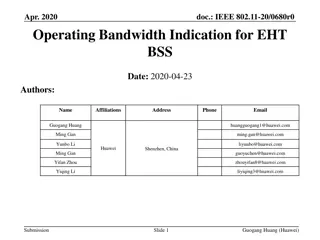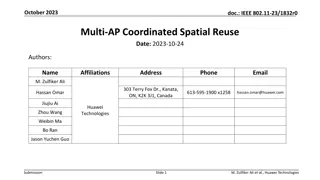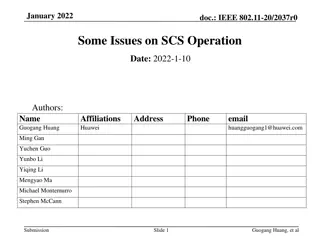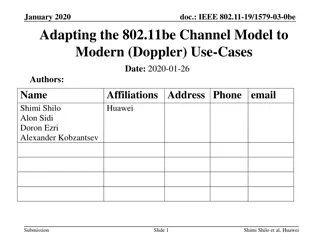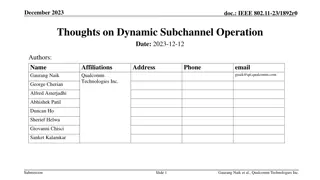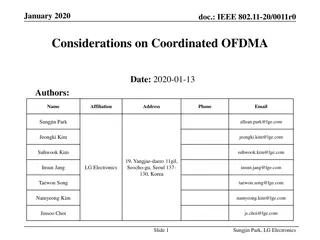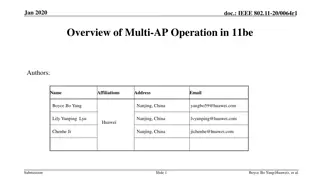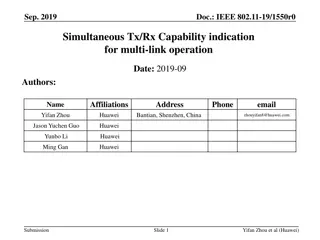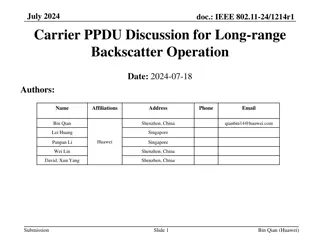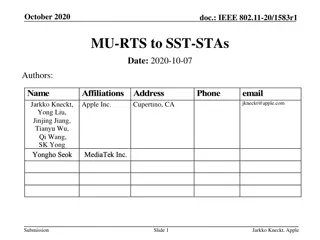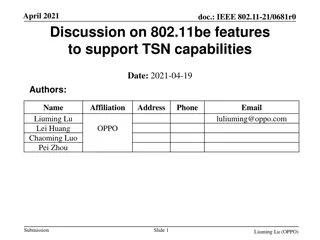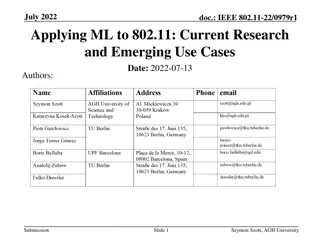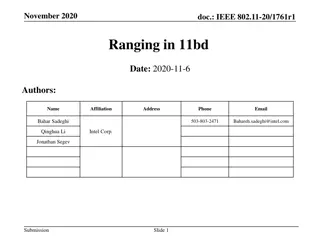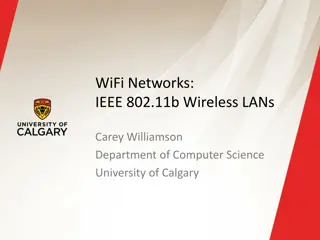IEEE 802.11-23/1913r1 Secondary Channel Access Operation
The document discusses the need for a secondary channel access (SCA) mechanism in IEEE 802.11bn to improve efficiency in wide bandwidth utilization. It covers the operation of SCA, technical issues, and solutions for successful frame exchange. Various considerations such as timing issues, medium synchronization, different channel switch times, and multiple SCHs for back-off are highlighted. AP announcement for SCA parameters and the mode for enabling/disabling SCA are also explained.
Download Presentation

Please find below an Image/Link to download the presentation.
The content on the website is provided AS IS for your information and personal use only. It may not be sold, licensed, or shared on other websites without obtaining consent from the author. Download presentation by click this link. If you encounter any issues during the download, it is possible that the publisher has removed the file from their server.
E N D
Presentation Transcript
November 2023 doc.: IEEE 802.11-23/1913r1 Secondary Channel Access Operation Date: 2023-11-12 Authors: Name Affiliation Address Phone Email Dongju Cha dongju.cha@lge.com Insun Jang insun.jang@lge.com Jinsoo Choi js.choi@lge.com Sunhee Baek Geonhwan Kim Yelin Yoon Eunsung Park sunhee.baek@lge.com geonhwan.kim@lge.com 19, Yangjae-daero 11gil, Seocho-gu, Seoul 137- 130, Korea yl.yoon@lge.com esung.park@lge.com LG Electronics Dongguk Lim dongguk.lim@lge.com Jinyoung Chun jiny.chun@lge.com Insik Jung insik0618.jung@lge.com HanGyu Cho hg.cho@lge.com 10225 Willow Creek Rd, San Diego, CA, USA Sanggook Kim sanggook.kim@lge.com Submission Slide 1 Dongju Cha et. al, LG Electronics
November 2023 doc.: IEEE 802.11-23/1913r1 Introduction According to the current spec, primary channel (PCH) is the only channel that can perform Back-off procedure and frame exchange is allowed only when primary channel is IDlE even when the remaining secondary channels are available This limits medium efficiency in wide bandwidth, so new mechanism, secondary channel access (SCA) or non-primary channel access (NPCA) that allows frame exchange even when PCH is BUSY needs to be defined in 802.11bn [1][2] In UHR SG and 11bn TG, many contributions discussed high level views for SCA and technical issues that need to be considered Most of the contributions have aligned views with slight different details [3]-[9] In this contribution, we discuss the operation of secondary channel access and some technical issues and solutions to achieve successful frame exchange when performing secondary channel access mechanism Submission Slide 2 Dongju Cha et. al, LG Electronics
November 2023 doc.: IEEE 802.11-23/1913r1 Overview: Secondary Channel Access Operation To perform Secondary Channel Access (SCA), AP needs to announce SCA related parameters [see next slide] When Basic NAV is set on a PCH due to OBSS PPDU, STA may switch to a SCH announced by AP to perform Back-off and frame transmission can be done without including a PCH In this contribution, we discuss the following things that should be considered when performing secondary channel access operation Timing issue / Medium Synchronization Different Channel Switch Time / TXOP end condition Multiple SCH(s) for Back-off Submission Slide 3 Dongju Cha et. al, LG Electronics
November 2023 doc.: IEEE 802.11-23/1913r1 AP announcement for SCA SCA related parameters shall be announced by an AP One or more SCH(s) for Back-off To perform SCA, at least one SCH for Back-off shall be announced When having multiple SCHs for Back-off, STA may get more gain in terms of channel access delay or channel access opportunity EDCA Parameter Set for SCH(s) E.g. EDCA Parameter Set for PCH can be shared with SCH while updating its own CW parameter Or, New EDCA Parameter for SCH(s) may be defined reusing the format of existing EDCA Parameter Set Secondary Channel Access (SCA) Mode (Enable/Disable) Used for indicating whether AP or STA supporting SCA enables SCA or not when the Basic NAV is set on the PCH Medium Synchronization (E.g., ED threshold, Max. num. of TXOPs, Duration) Channel Switch Time Channel switch time from PCH to SCH (vice versa) Submission Slide 4 Dongju Cha et. al, LG Electronics
November 2023 doc.: IEEE 802.11-23/1913r1 Considerations for Performing SCA Before performing SCA, AP and STA(s) having capability for SCA need to signal their SCA Mode whether it enables SCA or not to guarantee that a recipient STA is performing SCA when a Basic NAV is set on a primary channel Because some STA(s) may set an SCA Mode to be disabled for the purpose of power saving When the Basic NAV is set on the PCH, Both of an AP (tx side) and a STA(s) (rx side) may switch to SCH However, due to the different channel switch time, frame exchange may not be done successfully AP and STA(s) need to indicate their channel switch time to make sure AP transmits frame(s) after STA(s) has done switching Submission Slide 5 Dongju Cha et. al, LG Electronics
November 2023 doc.: IEEE 802.11-23/1913r1 Considerations for Performing SCA (cont d) After channel switching to SCH, One of AP or STA may not switch to an SCH due to different view on a PCH To make sure whether the Back-off channel of a recipient STA is aligned with transmitter, Frame exchange need to be initiated with a short control frame (e.g., RTS) STA(s) may loss medium synchronization on a SCH Medium access recovery procedure that performs EDCA w/ some restrictions may be needed [2] TXOP end condition on SCH TXOP on SCH shall be done before the Basic NAV timer expires on the PCH not to lose the medium synchronization on PCH Otherwise, STA(s) shall not obtain TXOP on SCH Also, STA(s) performing EDCA on SCH should complete switching to PCH considering the channel switch time from SCH to PCH before the Basic NAV timer expires on the PCH After switching back to PCH, STA(s) may loss medium synchronization This might happen due to CF-end frame sent from OBSS while STA(s) and AP are performing SCA (TXOP truncation on PCH) Submission Slide 6 Dongju Cha et. al, LG Electronics
November 2023 doc.: IEEE 802.11-23/1913r1 Multiple SCHs for BO When PCH is simultaneously performing PD/CCA w/ SCH, medium synchronization procedure is not needed Also, when having multiple SCH(s) for BO, STA(s) may get performance improvement in terms of channel access delay and channel access opportunity Because among multiple SCH(s) for BO, STA can transmit frame(s) through including one of SCH that Back-off counter value reaches to 0 first This can be good to meet the requirement for the latency sensitve traffic However, implementation complexity and power consumption for concurrent PD/CCA need to be considered Also, memory overhead is increased due to EDCA Parameter Sets and Back-off counter when having multiple SCH(s) for BO Submission Slide 7 Dongju Cha et. al, LG Electronics
November 2023 doc.: IEEE 802.11-23/1913r1 Conclusion In this contribution, we ve shared some thoughts to achieve secondary channel access in 11bn in terms of AP Announcement for SCA Techical Issues and Solutions Secondary Channel Access Mode Different Channel Switch Time Medium Synchronization/Timing issue TXOP end condition on SCH Multiple SCH(s) for Back-off Submission Slide 8 Dongju Cha et. al, LG Electronics
November 2023 doc.: IEEE 802.11-23/1913r1 Reference [1] 23/1112r0, Thoughts on Secondary Channel Access [2] 23/1911r0, Secondary Channel Access and Frame Transmission [3] 23/034r1, Non-primary Channel Utilization [4] 23/1444r1, Non-primary channel access evaluations_followup [5] 23/1419r0, Nonprimary channel access discussions [6] 23/1365r0, Discussions on Non-primary Channel Access [7] 23/797r0, Non-primary channel access [8] 23/1288r0, Non-primary Channel Utilization Follw-up [9] 23/1414r0, secondary channel usage follow up Submission Slide 9 Dongju Cha et. al, LG Electronics
November 2023 doc.: IEEE 802.11-23/1913r1 Straw Poll 1 Do you support to define a Secondary Channel Access (SCA) which allows STA to perform EDCA on a secondary channel when a Basic NAV is set on a primary channel due to OBSS PPDU? Submission Slide 10 Dongju Cha et. al, LG Electronics
November 2023 doc.: IEEE 802.11-23/1913r1 Straw Poll 2 Do you agree that an AP supporting Secondary Channel Access announces at least one secondary channel that performs EDCA The secondary channel is one of 20MHz channel in its BSS Operating Channel Width More than one secondary channel that performs EDCA is TBD Detailed signaling is TBD Submission Slide 11 Dongju Cha et. al, LG Electronics
November 2023 doc.: IEEE 802.11-23/1913r1 Straw Poll 3 Do you agree that a STA supporting Secondary Channel Access indicates its channel switch time that is required when a STA switches the channel that performs EDCA from a primary channel to a secondary channel How to indicate is TBD Submission Slide 12 Dongju Cha et. al, LG Electronics
November 2023 doc.: IEEE 802.11-23/1913r1 Straw Poll 4 Do you agree that a STA supporting Secondary Channel Access initiates frame exchange with control frame when it performs EDCA on secondary channel Subtype of control frame is TBD Submission Slide 13 Dongju Cha et. al, LG Electronics
November 2023 doc.: IEEE 802.11-23/1913r1 Straw Poll 5 Do you agree a TXOP that a STA obtains on a secondary channel shall end before the Basic NAV timer on a primary channel expires Submission Slide 14 Dongju Cha et. al, LG Electronics
November 2023 doc.: IEEE 802.11-23/1913r1 Straw Poll 6 Do you agree that a STA which performs EDCA on a secondary channel shall complete switching to a primary channel before the Basic NAV timer on a primary channel expires Submission Slide 15 Dongju Cha et. al, LG Electronics














